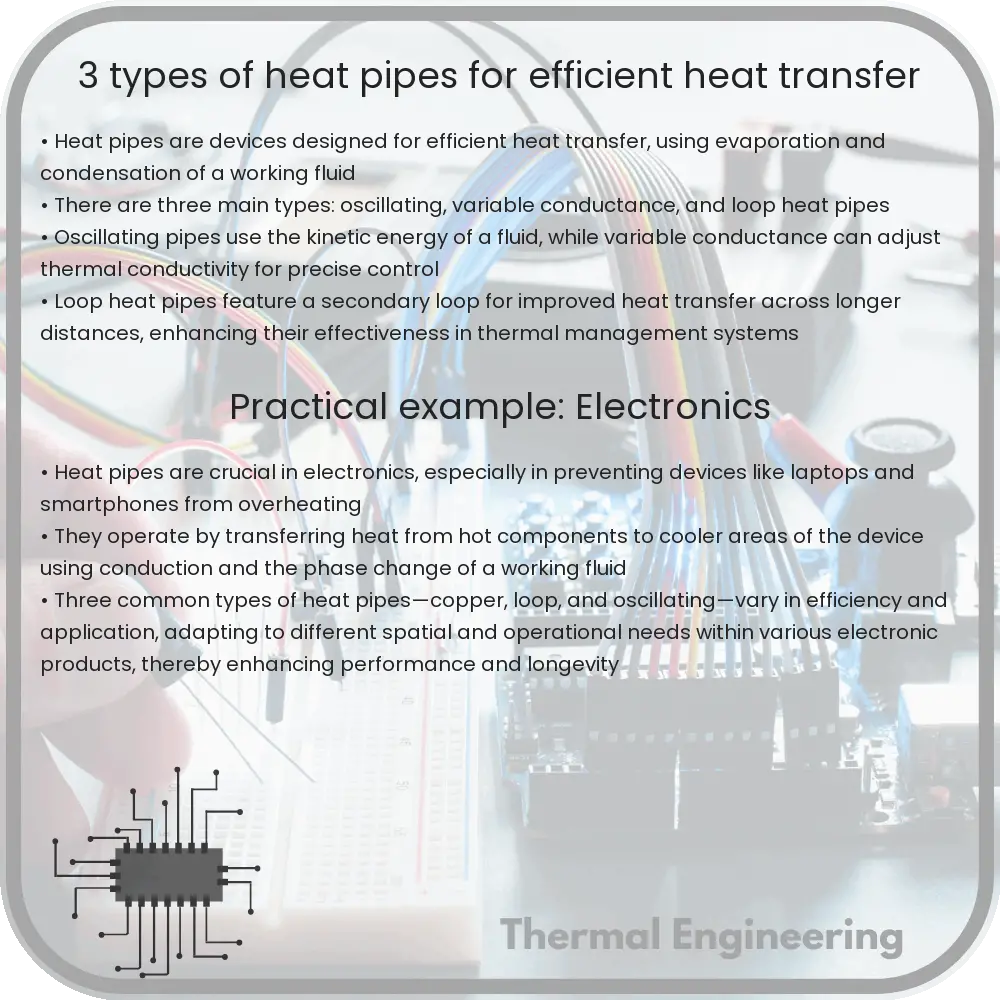Learn about heat pipes, highly efficient thermal conductors that leverage evaporation and condensation to transfer heat across various engineering applications.

Introduction to Heat Pipes
Heat pipes are highly efficient thermal conductors used in various engineering applications to transfer heat. They operate on the principles of evaporation and condensation, and are particularly useful in situations where conventional cooling methods are inadequate.
Basic Principle of Heat Pipes
A heat pipe typically consists of a sealed hollow tube made of a thermally conductive metal such as copper or aluminum. The tube is partially filled with a working fluid, which at operating temperature is in equilibrium between liquid and vapor phases. When one part of the pipe is exposed to a heat source, the fluid absorbs heat and transforms into vapor. The vapor travels along the pipe to a cooler area, where it condenses back into a liquid, releasing the latent heat. The liquid then returns to the hot end by capillary action through a wick structure lining the inner walls of the pipe, or by gravity in simpler setups, thus completing the cycle.
Types of Heat Pipes
There are several types of heat pipes designed to accommodate various applications and operational exigencies. Below are three common types:
1. Thermosyphon
Thermosyphons work on the principle of gravity-driven return of liquid and do not employ a wick structure. The evaporator section (heated section) is positioned below the condenser section (cooled section), letting gravity pull the condensate back to the evaporator. This type of heat pipe is simple in design and particularly effective in vertical applications where the heat source is at the bottom.
2. Wick-based Heat Pipes
In wick-based heat pipes, a porous wicking material is utilized to transport the working fluid from the condenser back to the evaporator against gravity. This allows the heat pipe to operate in any orientation, making it versatile for a variety of applications including aerospace and electronic cooling systems. Common wicking structures include:
- Sintered powder metal
- Mesh screens
- Grooved surfaces
3. Loop Heat Pipes
Loop heat pipes (LHPs) are a more advanced type of heat pipe that offer high-efficiency heat transfer over long distances and against gravitational forces. They consist of an evaporator, condenser, transport lines, and a compensation chamber that controls the operating pressure of the system and thus the overall temperature range. LHPs are particularly effective in systems where precise thermal control is required, such as satellites and spacecraft.
Applications of Heat Pipes
Due to their efficient heat transfer capabilities, heat pipes find applications across a broad spectrum of industries. They are used in:
- Electronics cooling (PCs, servers, etc.)
- Energetic systems (solar panels, heat exchangers)
- Aerospace (thermal management systems for satellites)
- Industrial processes where heat recovery is crucial
Conclusion
Heat pipes are a vital technology in thermal management systems, providing highly efficient solutions for transferring heat over various distances and orientations. Whether through simple thermosyphons, versatile wick-based designs, or advanced loop heat pipes, this technology continues to evolve and expand its application scope. Understanding the different types of heat pipes and their specific uses helps in optimizing thermal management strategies across several fields of engineering.